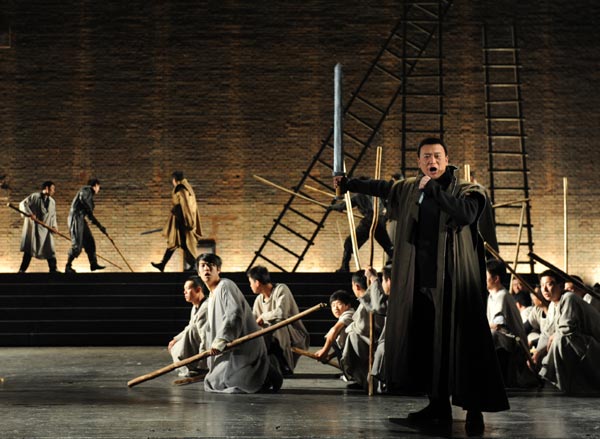

In the past two decades an experimental approach has been used - a hybrid of the "authentic" style and total localization. It's interesting to note that all such efforts are in the realm of theater, not opera. Tian Qinxin's new Romeo and Juliet, playing in various Chinese cities throughout 2014, retains key passages from the original text, but all the transitional scenes have been rewritten in the Beijing dialect. One moment Romeo is swearing like a kid from the hutong, or alley, the next he blurts out lines that only those in a sublime state could utter. This juxtaposition may puzzle some members of the audience, but if you treat the original texts as singing it begins to make sense. The setting seems to be a dreamscape that incorporates both Beijing and Verona.
Tian also transposed King Lear to the Ming Dynasty (1368-1644) because "the story fits any time, any place, as long as you capture its essence," according to Li Dong, the producer. Instead of a Shakespearean scholar, the writer of a popular historical novel set during the dynasty was hired to write the adaptation inspired by King Lear.
Subversion and soliloquies
Of all Chinese stage directors, Lin Zhaohua may be the most brilliantly subversive in staging Shakespeare. He doesn't change the text, but he never stops searching for new ways to bring out what he perceives to be new discoveries from the hoary classics. His production of Richard III toned down the royal atmosphere and played the intrigue and conspiracy like a game. His message: backstabbing happens everywhere.
Lin's Hamlet, periodically revived since its 1990 debut, is a psychological drama in which the protagonist must face his own weaknesses as well as the fickleness of fate. As Pu Cunxin, who has essayed most of the leading roles in Lin's productions of Shakespeare, realized, "There is no Danish prince, and I don't have to imitate movements foreign to me. It's just me - the feeble, hopeless, self-torturing intellectual. I learned to channel my own questions and interpretations into the play and find release and communication in the world of Shakespeare."
Lin's visualization of the most famous soliloquy in English theater - "To be or not to be" - has three actors speaking the lines together, facing each other, but off by a beat or two, thus creating an effect that the character is struggling with various aspects of himself. If a soliloquy is a solo aria, this one is now a trio.
This year, Lin's much acclaimed Coriolanus - premiered in 2007 and with a side stop in Edinburgh - will be revived as part of a strong lineup that the National Center for the Performing Arts has designed to celebrate the 450th anniversary of Shakespeare's birth. The celebration also includes Dunsinane by the National Theater of Scotland and Royal Shakespeare Company, a sequel to the Macbeth story, A Midsummer Night's Dream directed by Tim Robbins, a Romeo and Juliet that uses mostly body language, and Verdi's operatic rendition of Othello, among the other offerings.
This may well be China's busiest Shakespeare year - at least for a single venue - since the first Shakespeare Festival was held in April 1986, when 25 plays were staged in Beijing and Shanghai. But then, Shakespeare has never been out of vogue in the Middle Kingdom. In 1949 alone, the year New China was founded, as many as 13 of his plays were presented across the country.
Copyright ©1999-2018
Chinanews.com. All rights reserved.
Reproduction in whole or in part without permission is prohibited.